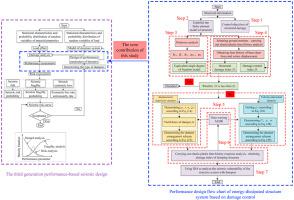Soil Dynamics and Earthquake Engineering ( IF 4.2 ) Pub Date : 2021-09-24 , DOI: 10.1016/j.soildyn.2021.106996 Wang Bao-shun 1 , Hao-xiang He 1 , Yan Wei-ming 1

|
The installation of energy dissipation devices on building structures can significantly reduce seismic damage. A brief review of first, second and third generation performance-based seismic design (PBSD) theories, and a comparative analysis of existing PBSD methods for energy-dissipated structure systems confirms that design methods based on force, displacement, and energy are inadequate. A more comprehensive approach is the damage-based design method, which can evaluate the seismic performance of structures. However, due to the lack of an analytical relationship between the additional equivalent damping ratio (AEDR) of dampers and the damage degree of the main structure, the current performance design method can only predict the expected damage via an iterative adjustment analysis of damper's design parameters. The authors addressed this problem by analyzing the damage mechanism of the energy-dissipated structure system's core area from the perspective of energy dissipation. It is established an analytical relationship between the AEDR and the damage index of the main structure with dampers via a damage model based on the energy difference ratio and the time-varying AEDR calculation of dampers subjected to ground motions. With this new approach to seismic vulnerability analysis, the performance design flow of the seismic structure system is based on damage control. A case study verifies the accuracy of the damage-degree based AEDR calculation. The proposed damage-based method effectively controls the damage degree of the main structure to the expected damage target. This method is compatible with the displacement-based design method, and which also enriches the research contents of structural seismic design and damage analysis in the third generation PBSD.
中文翻译:

基于损伤控制和时变阻尼比的消能结构系统抗震性能设计
在建筑结构上安装消能装置可以显着减少地震破坏。对第一代、第二代和第三代基于性能的抗震设计 (PBSD) 理论的简要回顾,以及对用于耗能结构系统的现有 PBSD 方法的比较分析证实,基于力、位移和能量的设计方法是不够的。一种更全面的方法是基于损伤的设计方法,它可以评估结构的抗震性能。然而,由于阻尼器附加等效阻尼比(AEDR)与主体结构损伤程度之间缺乏解析关系,目前的性能设计方法只能通过阻尼器设计参数的迭代调整分析来预测预期损伤。 . 作者从耗能的角度分析了耗能结构系统核心区的损伤机理,从而解决了这个问题。通过基于能量差比的损伤模型和阻尼器在地震动作用下的时变AEDR计算,建立了AEDR与带阻尼器主体结构损伤指数的解析关系。通过这种新的抗震易损性分析方法,抗震结构系统的性能设计流程基于损坏控制。案例研究验证了基于损坏程度的 AEDR 计算的准确性。所提出的基于损伤的方法有效地控制了主体结构对预期损伤目标的损伤程度。这种方法与基于位移的设计方法兼容,











































 京公网安备 11010802027423号
京公网安备 11010802027423号